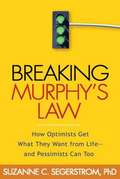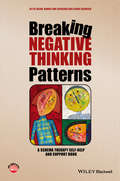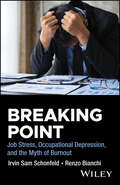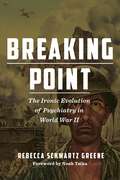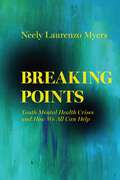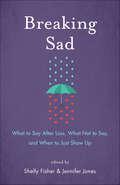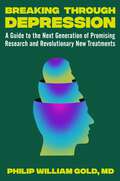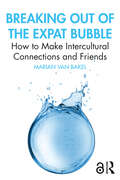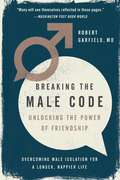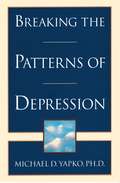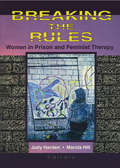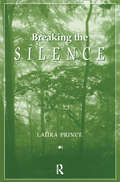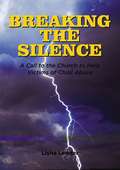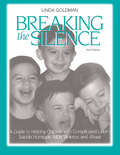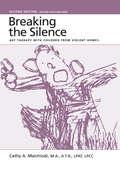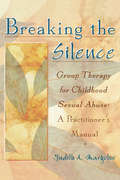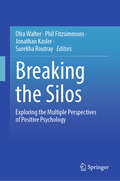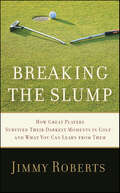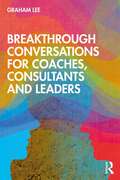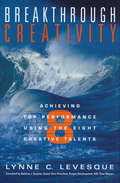- Table View
- List View
Breaking Free: My Life with Dissociative Identity Disorder
by Herschel WalkerThe NFL legend and Heisman Trophy winner shares the inspiring story of his life and diagnosis with dissociative identity disorder. Herschel Walker is widely regarded as one of football's greatest running backs. He led the University of Georgia to victory in the Sugar Bowl on the way to an NCAA Championship and he capped a sensational college career by earning the 1982 Heisman Trophy. Herschel spent twelve years in the NFL, where he rushed for more than eight thousand yards and scored sixty-one rushing touchdowns. But despite the acclaim he won as a football legend, track star, Olympic competitor, and later a successful businessman, Herschel realized that his life, at times, was simply out of control. He often felt angry, self-destructive, and unable to connect meaningfully with friends and family. Drawing on his deep faith, Herschel turned to professionals for help and was ultimately diagnosed with dissociative identity disorder, formerly known as multiple personality disorder. While some might have taken this diagnosis as a setback, Herschel approached his mental health with the same indomitable spirit he brought to the playing field. It also gave him, for the first time, insight into his life's unexplained passages, stretches of time that seemed forever lost. Herschel came to understand that during those times, his "alters," or alternate personalities, were in control. Born into a poor, but loving family in the South, Herschel was an overweight child with a stutter who suffered terrible bullying at school. He now understands that he created "alters" who could withstand abuse. But beyond simply enduring, other "alters" came forward to help Herschel overcome numerous obstacles and, by the time he graduated high school, become an athlete recognized on a national level. In Breaking Free, Herschel tells his story -- from the joys and hardships of childhood to his explosive impact on college football to his remarkable professional career. And he gives voice and hope to those suffering from DID. Herschel shows how this disorder played an integral role in his accomplishments and how he has learned to live with it today. His compelling account testifies to the strength of the human spirit and its ability to overcome any challenge.
Breaking Murphy's Law
by Suzanne Segerstrom Alan CarrPollyannas take heart, pessimists take note Recent studies on achievement and well-being show that optimistic behavior contributes to better physical health, greater resilience in the face of life's twists and turns, and more satisfying relationships. As psychologists Suzanne Segerstrom reveals, optimists lay groundwork for the success they envision. While the rest of us worry whether our goals are attainable, those who practice optimism try to achieve theirs. Breaking Murphy's Law shows you simple ways to develop the skills that natural-born optimists use to get what they want from life. Dr. Segerstrom helps you break free from the inertia of cynicism and self-doubt and encourages you to engage the world around you. "Doing optimism"--by getting involved, working hard, and enjoying your achievements--establishes a positive feedback loop that's both personally transformative and self-perpetuating. This practical book imparts the lesson with a mix of humor and intelligence that will convince even the most hardened cynics that Murphy got it wrong.
Breaking Negative Relationship Patterns: A Schema Therapy Self-Help and Support Book
by Bruce A. Stevens Eckhard RoedigerSchema Therapy (ST) was developed to treat patients with complex disorders, especially personality disorders, with a powerful new set of interventions. Personality disorders, as well as more general problems stemming from early experience and addressed by schema therapy, are a key factor in many disturbed relationships, and as a result ST is now increasingly used for couples work. By dealing effectively with the past, ST offers a unique way to approach and address present difficulties in relationships, Couples who understand their individual patterns of thinking and behavior tend to find that their relationships make much more sense. Breaking Negative Relationship Patterns is a readable, practical resource containing a wealth of self-help exercises that schema therapists can recommend or give to their patients. It is the ideal resource for couples undergoing schema therapy, and can also serve as an accessible self-help guide for those experiencing relationship difficulties. The authors offer a complete ST-based model for understanding complex personal problems, along with couple-specific adaptations of core ST interventions such as limited reparenting, imagery re-scripting and behavioral pattern breaking.
Breaking Negative Thinking Patterns
by Hannie Van Genderen Laura Seebauer Gitta JacobBreaking Negative Thinking Patterns is the first schema-mode focused resource guide aimed at schema therapy patients and self-help readers seeking to understand and overcome negative patterns of thinking and behaviour.Represents the first resource for general readers on the mode approach to schema therapyFeatures a wealth of case studies that serve to clarify schemas and modes and illustrate techniques for overcoming dysfunctional modes and behavior patternsOffers a series of exercises that readers can immediately apply to real-world challenges and emotional problems as well as the complex difficulties typically tackled with schema therapyIncludes original illustrations that demonstrate the modes and approaches in action, along with 20 self-help mode materials which are also available onlineWritten by authors closely associated with the development of schema therapy and the schema mode approach
Breaking Point: Job Stress, Occupational Depression, and the Myth of Burnout
by Irvin Sam Schonfeld Renzo BianchiBurnout has become a popular indicator of the distress that individuals can experience at work. In Breaking Point: Job Stress, Occupational Depression, and the Myth of Burnout, the authors, in the context of more than a decade of research, show how the phenomenon hidden behind the label of burnout is, in fact, depressive in nature. This book unravels the connections between work, depression, and burnout. The authors underline the dangers of mislabeling a depressive condition as burnout, including misdiagnosis, improper treatment, and unaddressed suicidality. Finally, they offer a path forward for individuals and society. By recognizing the depressive roots of burnout, human resources specialists and occupational health professionals can refer employees for appropriate treatment and understand how and why problematic working conditions must be changed. Review the history of depression and burnout and their connection to work Learn about research that supports occupational depression as a more valuable construct than burnout Understand and address the stigma that inhibits affected employees from seeking treatment Discover specific, research-grounded actions that occupational health specialists can take to prevent and address depression and burnout in the workplace
Breaking Point: The Ironic Evolution of Psychiatry in World War II (World War II: The Global, Human, and Ethical Dimension)
by Rebecca Schwartz GreeneWINNER, SOCIETY FOR MILITARY HISTORY DISTINGUISHED BOOK AWARDS - FIRST BOOKThis book informs the public for the first time about the impact of American psychiatry on soldiers during World War II.Breaking Point is the first in-depth history of American psychiatry in World War II. Drawn from unpublished primary documents, oral histories, and the author’s personal interviews and correspondence over years with key psychiatric and military policymakers, it begins with Franklin Roosevelt’s endorsement of a universal Selective Service psychiatric examination followed by Army and Navy pre- and post-induction examinations. Ultimately, 2.5 million men and women were rejected or discharged from military service on neuropsychiatric grounds. Never before or since has the United States engaged in such a program.In designing Selective Service Medical Circular No. 1, psychiatrist Harry Stack Sullivan assumed psychiatrists could predict who might break down or falter in military service or even in civilian life thereafter. While many American and European psychiatrists questioned this belief, and huge numbers of American psychiatric casualties soon raised questions about screening’s validity, psychiatric and military leaders persisted in 1942 and 1943 in endorsing ever tougher screening and little else. Soon, families complained of fathers and teens being drafted instead of being identified as psychiatric 4Fs, and Blacks and Native Americans, among others, complained of bias. A frustrated General George S. Patton famously slapped two “malingering” neuropsychiatric patients in Sicily (a sentiment shared by Marshall and Eisenhower, though they favored a tamer style). Yet psychiatric rejections, evacuations, and discharges mounted.While psychiatrist Roy Grinker and a few others treated soldiers close to the front in Tunisia in early 1943, this was the exception. But as demand for manpower soared and psychiatrists finally went to the field and saw that combat itself, not “predisposition,” precipitated breakdown, leading military psychiatrists switched their emphasis from screening to prevention and treatment. But this switch was too little too late and slowed by a year-long series of Inspector General investigations even while numbers of psychiatric casualties soared. Ironically, despite and even partly because of psychiatrists’ wartime performance, plus the emotional toll of war, postwar America soon witnessed a dramatic growth in numbers, popularity, and influence of the profession, culminating in the National Mental Health Act (1946). But veterans with “PTSD,” not recognized until 1980, were largely neglected.
Breaking Points: Youth Mental Health Crises and How We All Can Help (Ethnographic Studies in Subjectivity #18)
by Neely Laurenzo MyersA free ebook version of this title is available through Luminos, University of California Press’s Open Access publishing program. Visit www.luminosoa.org to learn more. Unprecedented numbers of young people are in crisis today, and our health care systems are set up to fail them. Breaking Points explores the stories of a diverse group of American young adults experiencing psychiatric hospitalization for psychotic symptoms for the first time and documents how patients and their families make decisions about treatment after their release. Approximately half of young people refuse mental-health care after their initial hospitalization even though we know that better outcomes depend on early support for youth and families. In attempting to determine why this is the case, Neely Laurenzo Myers identifies what matters most to young people in crisis, passionately arguing that health care providers must attend not only to the medical and material dimensions of care but also to a patient's moral agency.
Breaking Sad: What to Say After Loss, What Not to Say, and When to Just Show Up
by Shelly Fisher and Jennifer JonesReal stories and real feedback on what should be said, what should be kept to yourself, and what can be done when trying to support someone you care about as they navigate loss. Breaking Sad helps us start conversations through its pages of personal stories and suggestions from everyday survivors—bringing us all to a place where we can more comfortably offer support and caring to people when they need it most. Featuring stories from Montel Williams, Olivia Newton-John, Scott Hamilton, Giuliana Rancic, Valerie Harper, and more!
Breaking Through Depression: A Guide to the Next Generation of Promising Research and Revolutionary New Treatments
by Philip William Gold&“A thorough, up-to-date, and upbeat introduction to current scientific thinking about mood disorders and their treatment. An important resource for patients and their families—and for anyone curious about progress in psychiatric research."―Peter D. Kramer, Listening to ProzacThis inspiring exploration of the recent advances in depression research and treatment shares new methods that offer promising paths to wellness. Breaking Through Depression explores how the anatomy of the brain and the biochemistry of nerve impulses play a major role in how we view ourselves and the world. Drawing from his long-term research, Dr. Philip W. Gold makes the case for depression arising at the intersection of genetic vulnerability with stressful, disturbing life experiences that get encoded in our emotional memory. Breaking Through Depression will delve into the interplay between our anatomy and our lived experiences as the key to understanding why there are such individual differences in how we make connections with others, deal with adversity, or recover from trauma. More importantly, Dr. Gold reveals the latest breakthroughs that can heal people struggling with depression, including: The FDA has fast-tracked Psilocybin and Ketamine as anti-depressant treatments, which cause immediate improvement in depressive symptoms. Low-energy lasers have been developed that can stimulate these areas directly and painlessly to relieve symptoms in treatment-resistant patients suffering from major depression. Scientists are developing genetically &‘thumbprinted' antidepressants that can be individually tailored to match a person's DNA increasing their effectiveness. Inflammation in the body and the brain is a prominent component of depressive illness, to the point that anti-inflammatory agents are useful in the treatment of depression. Incredible progress with gene therapy including a treatment overcoming the BDNF gene mutation that interferes with resiliency, promotes vulnerability to depression, and inhibits the capacity of antidepressants to work effectively. These are just a few of the fascinating new developments explored in Breaking Through Depression and the many reasons for hope that Dr. Gold shares in this groundbreaking book.
Breaking Through to Teens
by Ron TaffelThis book presents groundbreaking strategies for psychotherapy with today's teens, for whom high-risk behavior, lack of adult guidance, and intense anxiety and stress increasingly come with the territory. Ron Taffel addresses the key challenge of building a therapeutic relationship that is strong enough to promote real behavioral and emotional change. He demonstrates effective ways to give advice that teens will listen to, get them to tell the truth about their lives, help parents reestablish their authority, and extend the reach of therapy by such nontraditional means as inviting teens to bring friends into sessions.
Breaking out of the Expat Bubble: How to Make Intercultural Connections and Friends
by Marian van BakelMoving abroad means having to settle into a new host country. This book enables expats and those who support them to create intercultural connections and friendships both within and outside the workplace.Having left behind a large part of their social network, expats need to make local friends to really settle in. This book shows you how this works, and that breaking out of the expat bubble and making local friends helps you adjust and settle in the new place you call home. Organisations and societies should also support expats if they would like to retain this international talent. It is important to create the conditions for expats to build a social network, for example by connecting them with a local buddy. Learn more in this book about the advantages of such contact and how to set up and manage a buddy system to the benefit of both your expats and your organisation or community. The book is illustrated by many quotes from almost 20 years of research and features 11 real-world experiences of expats around the world. It also includes practical recommendations for expats, organisations and societies.An invaluable resource on creating more intercultural connections and friendships in the workplace and the local community, this book will be well placed in the hand luggage of expats – especially those who go without much organisational support – as well as on the desks of managers and HR professionals who would like to better support expats on this great adventure.
Breaking the Male Code
by Robert GarfieldCalling for a new men's movement, a noted psychotherapist examines the critical role close male friendships play in helping men lead happy, healthy lives.For much of the past century, men have operated under the rules of Male Code, a rigid set of guidelines that equate masculinity with stoicism, silence, and strength. As men's roles have changed over the past few decades, this lingering pressure to hide their emotions has wreaked havoc on men's lives. Lacking the ability to communicate their needs, desires, and feelings effectively, they are more likely to suffer from depression, anger, and isolation, and their relationships often suffer. Noted psychotherapist Rob Garfield has worked with men struggling with emotional issues for more than forty years. Through his "Friendship Labs," clinical settings in which men engage in group therapy, he teaches men how to identify inner conflicts, express emotions, and communicate openly. According to Garfield, traditional therapy has largely marginalized men since many lack the tools to properly engage. But when men learn to open up to other men who share similar experiences, backgrounds, and perspectives, they not only build lasting bonds but learn the skills necessary to thrive in all aspects of their lives. Writing with empathy and authority, Garfield examines the unique challenges men face and urges them to abandon male code in favor of a masculinity that integrates traditional male traits with emotional intimacy skills. He urges men to connect with other men using the Four C's of intimacy--connection, communication, commitment, and co-operation--to form meaningful bonds. Drawing on real-life stories and original research, he shows how their friendships can serve as the foundation on which men can build and sustain deep relationships with all of their loved ones--including spouses, children, and parents--and in turn lead to happier, healthier lives.From the Hardcover edition.ication, commitment, and co-operation.
Breaking the Patterns of Depression
by Michael YapkoTwenty to thirty million Americans suffer from some form of diagnosable depression, and their ranks are growing. Psychologist Michael D. Yapko explains that in order to find relief, more than the current episode of depression must be examined. In Breaking the Patterns of Depression, he presents skills that enable readers to understand and ultimately avert depression's recurring cycles. Focusing on future prevention as well as initial treatment, the book includes over one hundred structured activities to help sufferers learn the skills necessary to become and remain depression-free.Breaking the Patterns of Depression begins by translating the clinical literature on psychotherapy and antidepressant medication into language that can be used to enhance an understanding of depression, and to personalize individual cures. Yapko uses a conversational, anecdotal tone that encourages readers to take an active approach to helping themselves. Special sections entitled "Learn by Doing" and "Shifting Perspectives" help develop the skills necessary to manage difficult experiences. Readers learn how to solve problems effectively, anticipate the likely consequences of their actions, think and act in a direct, goal-oriented fashion, balance different areas of their lives, and use self-knowledge to stay out of harmful situations.More realistic and helpful than other depression-management books on the market, Breaking the Patterns of Depression defines what causes depression and, best of all, clarifies what can be done about it. With this knowledge in hand, readers can control their depression, rather than having depression control them.From the Trade Paperback edition.
Breaking the Rules: Women in Prison and Feminist Therapy
by Marcia Hill Judith HardenBreaking the Rules: Women in Prison and Feminist Therapy challenges therapists, public policymakers, voters, and those in the criminal justice system to find treatment options, empowerment strategies, viable resources, community support, and policies that can help women with problems such as drug abuse, domestic violence, poverty, and prostitution rather than perpetually punishing them.Breaking the Rules shows you how our society makes ‘other’of those among us who are most vulnerable, injured, and without resources. It digs under your skin and forces you to look at: the histories of abuse among women who have murdered their partners the impact of race and ethnicity on patterns of mothering and caretaking of children of women prisoners the lack of treatment options for addicted women prisoners how prison reawakens the feelings of powerlessness in women who have suffered childhood physical and sexual abuse helping women inmates develop marketable educational and vocational skills, support systems, and positive perceptions of themselves collaborative strategies that challenge the status quo of programs and support available to female offenders and their families a relational model of treatment that is based on the integration of three theoretical perspectives the strengths and limitations of twelve step programs for womenMapping the problems and offering solutions, Breaking the Rules walks you through treatment strategies and self-confirming experiences--such as feminist therapy, prisoner-led support groups, affirmative prison programming, and art therapy--that help women draw on their strengths, come to terms with their pasts, and meet future challenges head on.
Breaking the Silence (Death, Value, And Meaning Ser.)
by Laura PrinceBreaking the Silence covers the long term consequences of unresolved childhood grief. Intended for psychologists, clergy, and therapists and school guidance counselors specializing in treating dysfunctional families, grief counseling for the family, unresolved grief issues, etc. This book is also especially appropriate for students of psychology and death and bereavement courses.
Breaking the Silence: A Call to the Church to Help Victims of Child Abuse
by Lisha LenderThe hard truth is that no church or faith-based community is immune to having child abuse happen within its church families. Breaking the Silence will educate you about the realities of child abuse and why many victims blame God for abuse, have a misguided understanding of who He is, and walk away from God and the church.It is time for the church to be educated about child abuse and take a stand to support victims. Child abuse includes physical, sexual, and verbal abuse as well as neglect and living in domestic violence. The majority of child abuse is perpetrated by someone in the victim&’s family or someone the victim has a close relationship with. Go into the life of victims and learn how they are impacted their entire life by those who abuse them. The ACE study is an eye-opening reality check of the lasting effects of child abuse on victims.Abuse within the family system keeps most victims quiet. Victims feel alone and isolated. This isolation affects every relationship the victim has, now and in the future, especially their relationship with God.It is time for the faith community to be actively involved in helping victims of child abuse. Child abuse is a crime committed against the very children God has entrusted to us. This is not about protecting the church or maintaining family unity. It is about helping people thrive and live the life God intended for them. This can only happen when the church steps up and is willing to face the reality of the brokenness within many of its church families.There is a desperate, silent cry from millions of victims just waiting for someone to notice them, believe them, and help them heal.Breaking the Silence is written as a call to educate the church, but it is loaded with information anyone will find useful. Everyone needs to know and understand the realities of child abuse. Whether you know it or not, abuse is happening in your town, in your neighborhood, and possibly in your own home.We tend to remain silent about things we do not understand. It is time to break the silence.
Breaking the Silence: A Guide to Helping Children with Complicated Grief - Suicide, Homicide, AIDS, Violence and Abuse
by Linda GoldmanThe second edition of this bestselling book is designed for mental health professionals, educators, and the parent/caregiver, this book provides specific ideas and techniques to work with children in various areas of complicated grief. It presents words and methods to help initiate discussions of these delicate topics, as well as tools to help children understand and separate complicated grief into parts. These parts in turn can be grieved for and released one at a time.A new chapter is included, called "Communities Grieve: Involvement with Children and Trauma." It includes information on The Taiwan Earthquake and how the community worked with children, a school bus accident in which 36 elementary school children witnessed the death of the bus driver that was driving and how the school system worked with these children and their families; a boy who was running on a cross country team and got hit by a car, which was witnessed by teammates; and how a non-profit community grief agency worked with family, school, and community. The last study is from the Oklahoma bombing and the outgrowth of a place for the traumatized children and how they still work with kids and family today. This chapter then contains new activities to work with traumatized grieving children.The new edition also includes updated resources, books, curriculums, websites, hotlines and another new chapter on bullying and victimization issues. The chapter for educators has been expanded, including the coverage of topics such as at-risk students, gay and lesbian issues, and self-injurious behaviors.
Breaking the Silence: Art Therapy With Children From Violent Homes
by Cathy MalchiodiFirst published in 1997. Routledge is an imprint of Taylor & Francis, an informa company.
Breaking the Silence: Group Therapy for Childhood Sexual Abuse, A Practitioner's Manual
by Judith MargolinA program you can use for time limited clients suffering from sexual abuse!Breaking the Silence: Group Therapy for Childhood Sexual Abuse guides you through initial establishment and group formation to its termination. The step-by-step approach outlines themes and issues common to this population, raises pertinent questions, and highlights common pitfalls or problem areas in conducting therapy. You’ll discover innovative ways to work with survivors of childhood sexual abuse by addressing these key therapy issues: issues of trust, sexuality, and disclosure family dynamics emotional expression transference/countertransference male survivors group sessions the impact of abuse a concise fifteen-session, time-limited, psycho-educational group therapy program for adult survivors of sexual abuseThe program planning approach described in Breaking the Silence allows you to adapt the program to meet your individual clients’needs. The concise fifteen-session, time-limited psycho-educational group therapy program for adult survivors of sexual abuse is designed to therapeutically address the long-term sequelae associated with a past history of child abuse. The literature review of childhood sexual abuse treatment, along with this program and the invaluable sections on male survivors, sexuality, and other areas dealing with the emotional repercussions of childhood sexual abuse, are invaluable sources of information for helping survivors develop and maintain healthy relationships and balanced lives.
Breaking the Silos: Exploring the Multiple Perspectives of Positive Psychology
by Surekha Routray Ofra Walter Phil Fitzsimmons Jonathan KaslerThis book offers a new look at well-being from a multidisciplinary standpoint. Research from industry clearly indicates that factors such as creativity, critical awareness, well-being, interdisciplinary understanding of positive psychology, and the ability to form strong relationships will determine the viability of organizations as collectively we enter the second half of the twenty-first century. Thus, a sound understanding of how these facets become melded into entrepreneurship, the workplace environment, and creative innovation is a requirement for individuals in the workplace. With a dearth of information about these facets as individual components and as a collective whole, this book draws these elements of overall well-being into a multidisciplinary focus. Thus, with chapters covering diverse fields such as philosophy, education, economics, mathematics, and medicine, the book offers a fresh approach to how positive psychology impacts entrepreneurship.
Breaking the Slump: How Great Players Survived Their Darkest Moments in Golf—and What You Can Learn from Them
by Jimmy RobertsIn Breaking the Slump, NBC golf commentator Jimmy Roberts shares the “slump stories” of some of the greatest professional golfers of all time—from Arnold Palmer, Jack Nicklaus, and Tom Watson to Phil Michelson and Dottie Palmer—offering valuable tips and strategies to help any player overcome that inevitable stretch of absolutely wretched golf.
Breakthrough Coaching: Creating Lightbulb Moments in Your Coaching Conversations
by Marcia ReynoldsLight bulb moments in coaching are the creative insights that change minds and lives.A new, highly actionable guide for disrupting the narratives holding clients back from resolving problems and making the changes they want in themselves, Breakthrough Coaching provides methods, resources, and exercises to help you activate immediate and sustainable shifts in perspective and behavior, moving you forward on your path of coaching mastery.Stop being haunted by doubt and discomfort. Discover how to quickly create safety and connection so your clients accept when you challenge their thinking. Then know what to say that evokes the creative flashes of insight that change their minds and lives forever.Read Breakthrough Coaching to unlock access to:5 Modules of learning and discovery19 Resource Tools and 5 Practice ExercisesCoaching case studies and examplesAnd so much moreNo longer will you worry "can I really say that?" or "should I have said more?" Instead, you'll be able to reveal deep desires and dreams, shine a light on blind spots and mental blocks, and open your client's minds to new perspectives that change their stories ripe with new possibilities-in less than an hour of your time together.
Breakthrough Conversations for Coaches, Consultants and Leaders
by Graham LeeConversational effectiveness is a barometer of human thriving and facilitating insightful conversations is a powerful method for accelerating psychological change and collaboration. This ground-breaking professional book provides a map of Breakthrough Conversations together with a practical toolkit for enhancing awareness, emotional resilience and creativity. Neuroscience, mindfulness and psychological research shows that awareness is pivotal to skilful conversations. By supporting clients to observe and manage their own body-brain states during conversation, they can learn to switch on the physiological systems that support more authentic, agile, and attuned interactions. Three body-brain states, reactive, habitual and reflective – characterised as Red, Amber and Green (RAG) - are differentiated in terms of body-sensations and behaviours, and these correspond to predictable interactive patterns. Facilitated to experience more emotionally resilient conversations, clients access their natural capacities for collaboration, compassion and shared creativity. This journey, through the five stages of Breakthrough Conversations, drawing on the RAG frame and a number of other practical models, is richly illustrated with case studies from working one-to-one and with pairs. Coming to see conversations as a dance driven by the interactions of underlying needs and emotions frees clients to make paradigm shifts in their self-awareness and interpersonal effectiveness. This book, and the approach it outlines, will be essential reading for coaches, consultants, leaders and all professionals seeking to choreograph more insightful conversations.
Breakthrough Creativity: Achieving Top Performance Using the Eight Creative Talents
by Lynne C. LevesqueHoward Gardner's classic book Multiple Intelligences exploded the myth that intelligence can be measured along a single dimension. Now Lynne Levesque shows that creativity, like intelligences, exists in a variety of forms, and demonstrates that high-performance organizations need to make use of creativity in all its dimensions. It takes more than just "thinking outside the box" to build a flexible, adaptive organization that will survive competitive battles, grow and prosper, and provide the environment that attracts and keeps the best talent. On the basis of her research in personality, innovation and creativity, as well as her experience helping top executives achieve their full potential, Levesque describes eight distinct creative talents. People of each talent have a unique way of looking at challenges, collecting data and generating creative solutions. Breakthrough Creativity describes in individual chapters how each talent works, how each contributes to the creative process and how each can improve decision making, team building and strategic planning and thinking. Breakthrough Creativity brings to life the stories and rich experiences of working individuals around the world to help readers discover their own creative talents and use them to further their professional and personal lives.
Breakthrough Moments in Arts-Based Psychotherapy: A Personal Quest to Understand Moments of Transformation in Psychotherapy
by Aileen WebberIn psychotherapy clients sometimes experience breakthrough moments - profound moments in which their world and how they view themselves is changed for ever. But what exactly occurs during such moments? In Breakthrough Moments in Arts-Based Psychotherapy the author shares her very personal journey to discover what might be happening at these pivotal moments and demonstrates their importance for clients' change processes. Filled with examples from her own practice, the book dips into the worlds of chaos and complexity theory, neuroscience, quantum physics, and theories of change, in order to show how the use of arts-media in psychotherapy - visual images and drawing, drama and music, sand-tray and enactment - can encourage the arrival of these dramatic breakthrough moments. The aim of this unique book is to shine a spotlight for the first time on a deeply profound aspect of arts-based psychotherapy in an accessible and engaging way.

